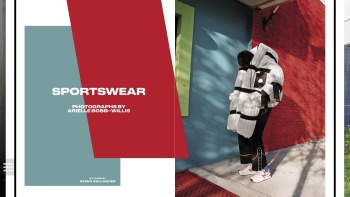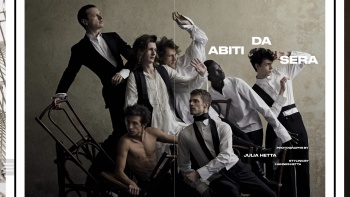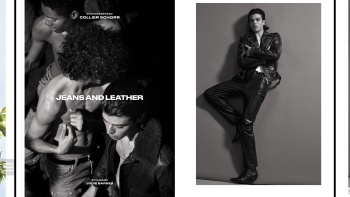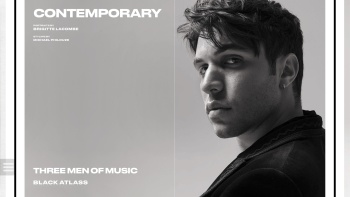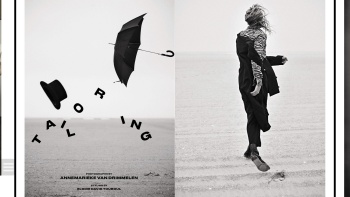-
Announcing... The WINNERS of the 2025 theFashionSpot Awards:
Designer of the Year
Ready-to-Wear Collection of the Year
Haute Couture Collection of the Year
Model of the Year
Photographer of the Year
Stylist of the Year
Magazine Cover of the Year
Ad Campaign of the Year
Congratulations to ALL of our worthy winners! Thank you to our tFS forum members who voted and participated.
You are using an out of date browser. It may not display this or other websites correctly.
You should upgrade or use an alternative browser.
You should upgrade or use an alternative browser.
L'Uomo Vogue June 2018 : Rogier Bosschaart by Julia Hetta
- Thread starter MDNA
- Start date
Phuel
Well-Known Member
- Joined
- Feb 18, 2010
- Messages
- 6,303
- Reaction score
- 11,497
If you really want to laugh Julia Hetta framed her work and put them on her house
I know quite a few who do that as well. Not my preference, but I can understand when people feel proud of their accomplishments and want to frame their work on the cover of a magazine... Tacky, but oh well.
The cover layout is atrocious, looking like some ad for a hair convention. Collier's portrait is the only one that stands out, and that's because of Kobe's looks. Just please make an effort with a hint of high fashion as well? (Liked the Pharrell shot until I saw that it was Pharrell...)
Disappointed with this afterthought of a relaunch. It's likely going to just resemble any other men's rag out there presently in its content, while its main purpose is just as another means to get those advertiser coins. I doubt it will bother to have a voice like L'UOMO did, in its glory.
Benn98
Well-Known Member
- Joined
- Aug 6, 2014
- Messages
- 42,582
- Reaction score
- 20,792
Behold the male Anna Wintour! I think despite Farneti's shortcomings as magazine editor, and there are quite a few imo, what is admirable is that he's looking at how his position can shape fashion beyond the pages of VI. He's trying his best to rejuvenate Italian fashion, and God knows they need it. That's commendable! I'd bracket him along with Anna, Angelica, and Edwina. Alt being their polar opposite. Not quite sure what to make of Edward....
Source: Nytimes.com
L’Uomo Vogue Lives Again
By Guy Trebay
June 15, 2018
Reduce, reuse, recycle. The old call to arms for greener living has finally infiltrated fashion, which generally follows the less enlightened pattern of produce, dismiss, discard.
Take the example of L’Uomo Vogue, the influential Condé Nast magazine that did much to promote a progressive vision of men’s wear, visual culture and even, on occasion, politics.
Soon after Franca Sozzani, editor of both Vogue Italia and L’Uomo Vogue, died in late 2016, her position was taken over by Emanuele Farneti, then a 42-year-old journeyman well-known to the world of Italian magazine publishing and yet still a surprising choice for the hire. “I wouldn’t have thought of me necessarily either,” he told The New York Times at the time.
Tempered enthusiasm initially greeted the hiring of Mr. Farneti — a man, a fashion outsider and a distinctly low-profile figure assuming a role long played by a woman who had singularly transformed herself into an identifiable brand. And then Condé Nast announced later in 2017 that, in a belt-tightening move, it would shut down various satellite Vogue editions — for brides, children, jewelry and men — over which Ms. Sozzani had long held sway.
Among the sundry ways Ms. Sozzani made her mark on fashion, it was her aesthetic savvy that stood out. During her long tenure she scouted and provided a platform for photographers who would become major names in the field. “It had a piercing presence because the photography was outstanding,” said Angelo Flaccavento, a fashion critic and curator based in Milan. “Masters like Oliviero Toscani and Alfa Castaldi were prominently featured and very active in the definition of the evolved and energetic man L’Uomo Vogue stood for.”
There was something more. “Mainly L’Uomo Vogue mattered because it was a huge business,” Stefano Tonchi, the editor of W Magazine, wrote from New York in an email. In an era when publishing relied on advertising and not online subscriptions for survival, L’Uomo Vogue was a robust cash cow. “L’Uomo Vogue was created as a service and a house organ for the Italian men’s wear industry,” he said.
Yes, there had been men’s wear before the delightful circus of men’s fashion as we now understand it. Italian designers “invented men’s pret-a-porter and L’Uomo Vogue was its voice and its image,” Mr. Tonchi said, noting that, with its superhero models and unabashed worship of traditional maleness, L’Uomo Vogue was first among fashion magazines unafraid to celebrate “the vanity and beauty of a man.”
A collective cry of dismay went up when L’Uomo Vogue folded last year and Mr. Farneti let go much of its staff. An equivalent expression of surprise greeted the news this week that the magazine was back in business, resurrected as a quarterly with its first issue out Thursday.
Superficially, the revamped magazine has a new look, an impressively larger 10 inch by 12 inch trim size, an editorial emphasis on inclusiveness and an approach to the contested territory of gender that Mr. Farneti claims is part of his mission. It is also printed in English rather than in Italian because, as he said, “That’s the international language and it’s an international magazine.”
To mark the magazine’s comeback, Condé Nast has scheduled a 50th anniversary party on Sunday in the heart of Milan, inviting more than 100 of the publishing and fashion elite in the city to celebrate the arrival of another thick block of glossy paper full of images whose divergence from those to be found in the magazine’s previous iterations was not altogether conspicuous.
The varied meanings of manhood have, indeed, altered, as Mr. Farneti noted in an interview several days before the launch. In Florence to attend the Pitti Uomo men’s wear trade fair, the largest in the world, he had joined an unlikely assortment of V.I.P. guests — the model and influencer Lucky Blue Smith and Tim Cook, the Apple chief executive, among them — at a Cavalli show held in the courtyard of the 14th-century Florence Charterhouse beneath a cerulean Tuscan sky.
“The worst thing a quarterly can do is to look like a magazine that comes out every once in a while,” said Mr. Farneti who, handsome in his tidy blue suit and polished loafers, resembled less the editor of an adventurous fashion magazine than a Macron-style government bureaucrat. “We want to be as plural as possible,” he added of a decision to commission five female photographers to shoot portfolios with men as their subjects, an odd assertion that seemed to treat gender parity in hiring as a noteworthy event and not the norm, as might be expected.
Still, for all that societal notions of what constitutes masculinity are being contested, there is little doubt that this is a compelling moment for men’s fashion. The open work space models of a digital age have altered beyond recognition what constitutes a uniform for the office, with suits now restricted to only the most traditional forms of employment and, perhaps, a day in court.
At houses like Louis Vuitton, Dior Homme, Burberry and Céline, designers as disparate as Virgil Abloh, Kim Jones, Riccardo Tisci and Hedi Slimane have been brought in to recast the image of men in a modern consumer marketplace. And a posse of talented newcomers like Gosha Rubchinskiy, Simon Porte Jacquemus, Craig Green, Benjamin Alexander Huseby and Serhat Isik (of GmbH) and Matthew Williams (of Alyx) have arrived on the scene to shake things up.
“Even the Italian sartorial style is not a category that has the same meaning as it had before,” Mr. Farneti said, referring to the tailoring that still dominates Pitti Uomo yet is now in a battle for continued existence.
“What we used to call a mash-up is now normal,” he added of the new blended dress codes, as reflected in a magazine that features all the usual men’s magazine content on apparel and toys and grooming products but with the addition of a section of editorial pages devoted to the footwear that now is the single largest driver in the men’s wear business.
Though the generation that a revitalized L’Uomo Vogue hopes to lure to its pages may consume every new gadget that Apple churns out, it probably does not want to dress the way that, at 57, Mr. Cook does. Attired in a smart blue suit and tie for the Cavalli show, the executive seemed bemused by a parade of scrawny male models clomping around a carpeted runway left soggy by afternoon thundershowers. While Mr. Cook wore a pair of conservative lace-ups, the models showing the designer Paul Surridge’s short-short sets or animal-patterned track suits were shod in the sneakers that, in the manner of the moment, were roughly the size of pontoons.
Source: Nytimes.com
Last edited by a moderator:
D
Deleted member 130879
Guest
Loving Julia's cover. I don't understand the hate. This is by far better than what Testino and the whole "photoshop" troopers have been doing for the past 20 years, killing fashion photography one airbrush at a time. It's also incredibly refreshing during this "cool kid" age (like Arielle's cover) when everyone is completely blinded by "youth", "streetwear", "kitsch", "Berlin".
What is with all the hate towards photographers that prefer to be working towards a portrait photography imaginary rather than pure fashion? Lindbergh and Roversi have been working in that path since forever. Fashion is always an accessory to their photography.
I don't want to live in a world where fashion photography is seen solely as a vehicle to sell clothing.
What is with all the hate towards photographers that prefer to be working towards a portrait photography imaginary rather than pure fashion? Lindbergh and Roversi have been working in that path since forever. Fashion is always an accessory to their photography.
I don't want to live in a world where fashion photography is seen solely as a vehicle to sell clothing.
D
Deleted member 1957
Guest
incredibly boring cover! What happened to fashion? Its lost its appeal
D
Deleted member 141523
Guest
all the eds are in vogue.it, section of covers and fashion stories. You're welcome 

Last edited by a moderator:
D
Deleted member 141523
Guest
all the eds are in vogue.it, section of covers and fashion stories. You're welcome 

Last edited by a moderator:
Similar Threads
- Replies
- 17
- Views
- 7K
- Replies
- 0
- Views
- 1K
Users who are viewing this thread
Total: 1 (members: 0, guests: 1)


